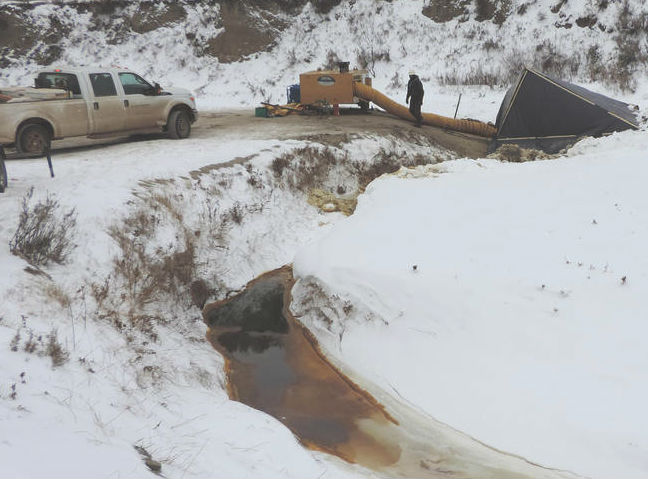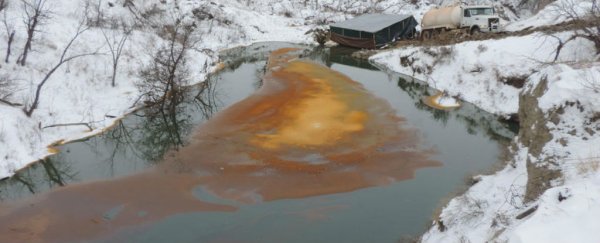A faulty pipeline has leaked 176,000 gallons of crude oil into a creek and the surrounding countryside 2.5 hours away from the Standing Rock protests in North Dakota.
The spill, which went undetected by the pipeline owners until a local stumbled on it, has spread almost 7 km (5.4 miles) from the site of the leak, and at this stage, it's not clear what caused the pipe to rupture, or how long it's been leaking.
According to CNN, an estimated 4,200 barrels of crude oil leaked from the Belle Fourche Pipeline in Billings County, 150 miles (241 km) from Cannon Ball in North Dakota, where protesters have been fighting the construction of the Dakota Access Pipeline.
For months, opponents of the Dakota Access Pipeline have been expressing fears that it would affect local drinking water, because it was to be built under the Missouri River near the Standing Rock Sioux Reservation - the primary water source of the Standing Rock Sioux tribe.
Last week, the US Department of the Army announced that it would not approve the crossing of the pipeline under the Missouri River.
The massive nearby spill - which was discovered on the same day that the Dakota Access Pipeline construction permit was denied - might have just proved the protesters' point.
As Derek Hawkins reports for The Washington Post, the Belle Fourche Pipeline Co., which owns the leaky pipeline in Billings Country, estimates that 130,200 gallons of oil spilled into the Little Missouri River last week, and another 46,200 gallons leaked onto a hillside.
The North Dakota Department of Health confirmed that the spill had taken place on December 5, and then again yesterday.
"Due to potentially unstable soil conditions at the point of release, the cause of the incident is not yet known," the Department of Health announced.
"The section of pipeline where the leak occurred has been isolated, and the spill has been contained."
 North Dakota Department of Health
North Dakota Department of Health
According to Bill Suess, an environmental scientist with the North Dakota Department of Health, 37,000 gallons of oil had been recovered as of Monday, but there's still a whole lot more to go.
"It's going to take some time," Suess told the Associated Press. "Obviously there will be some component of the cleanup that will go toward spring."
And while local drinking water will not be affected, at least two cows have been confirmed dead in the area, but a definitive connection between their deaths and the oil spill has not been made.
It's also not clear how the pipeline ruptured in the first place, but Belle Fourche Pipeline spokesperson, Wendy Owen, told the Associated Press that it might have occurred when the hillside slumped due to increased snowfall.
"That is our number one theory, but nothing is definitive," she said. "We have several working theories and the investigation is ongoing."
Perhaps even more concerning than a freak accident splitting the pipe is the fact that electronic monitoring equipment failed to detect the leak - something that would have prevented the pipe from spilling so much oil out into the countryside.
While there's no guarantee that a leak like this would happen at the Dakota Access Pipeline, this kind of thing is not exactly rare in the area.
As Hawkins reports for The Washington Post, True Companies, which owns Belle Fourche Pipeline Co, has a history of oil leaks in the region, reporting more than 30 spills totalling 320,000 gallons of oil since 2006.
"The Poplar Pipeline, operated by a True Companies subsidiary, leaked about 30,000 gallons of crude oil into the Yellowstone River in eastern Montana in 2015, prompting a town to shut down its drinking water service to 6,000 residents," he adds.
Belle Fourche Pipeline Co. has reported 10 oil spills since 2011.
So while none of that means the Dakota Access Pipeline is necessarily a risk, the Billings County leak is making the protesters' point for them: it's clear we need to do a better job at ensuring the structural integrity of those pipes.
